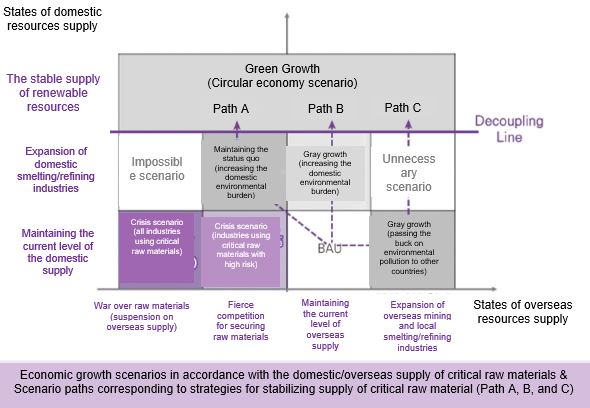■Stability in the supply of critical raw materials as the future agenda
⭘The soaring global demand for critical raw materials in the high-tech industry has underscored the need for a stable supply of these minerals.
⭘China is the leading exporter of critical raw materials to Korea, with Korea's import dependence for some materials from China exceeding 80%. This presents a substantial risk to the stable growth of Korea's strategic industries.
⭘Therefore, it is imperative to identify and address issues in the global supply chain of critical raw materials and vulnerabilities in the domestic industry. Proposing solutions for these challenges is essential to ensure economic security and enhance the competitiveness of future industries.
⭘This paper outlines Paths A to C, illustrating various strategies aimed at augmenting the supply of raw materials from either domestic or international sources. This approach is a proactive response to the anticipated increase in demand for critical raw materials, driven by the policy orientations of major countries that focus on mid- and long-term green growth trajectories.
-This paper includes an examination of national strategies essential for the transitional phase and seeks to formulate a strategy grounded in the current state of technological development. Technologies proposed in this strategy are intended for application both in the transitional period and the subsequent phase of green growth.

■The current state of critical raw materials supply chain
⭘Critical raw materials are imperative for the growth of future industries and sustainability, and the control and procurement of critical raw materials have emerged as significant issues amid the US-China Trade War.
⭘China, the leading producer of critical raw materials, holds the largest share in production and boasts a dominant advantage, particularly in the supply of these materials at the processing stage, rather than the extraction stage.
⭘Key producers’ political instability or institutional problems as well as China’s dominance in the supply of critical raw materials raise concern over the stability of the supply chain.
■Key countries’ strategies in response to the challenges to economic security posed by securing the supply of critical raw materials
⭘China exercises significant control and influence over critical raw materials essential for the green transition, a fact that is clearly reflected in its strategic vision and national mid- and long-term planning.
-China has a significant share in the processing and possession of critical raw materials, such as lithium, nickel, and cobalt, for which demands are projected to surge over the next three decades.
⭘As various countries restrict mining activities due to environmental concerns, China holds a monopoly over the majority of critical raw materials. This situation necessitates that other countries formulate strategies to improve the stability of their raw materials supply. Such strategies are crucial for enhancing competitiveness in future industries, especially in sectors where the emphasis on green transition is increasingly paramount.
⭘Key countries acknowledge their dependence on China for critical raw materials as a strategic risk and are consequently developing response strategies and systems. In response, China underscores the significance of its national strategy for the supply chain management of critical minerals and raw materials.
-The EU announced the first draft of the 'Critical Raw Materials Act' (the “CRMA”) while developing a number of response strategies for a stable supply of critical raw materials.
-The United States and Korea acknowledge the importance of strengthening the legal system and international cooperation to ensure a stable supply of critical minerals and are exploring elaborate measures to address this need.
-China is concurrently elevating the strategic value of critical minerals and raw materials while prioritizing the security of supply chains and industrial networks to bolster the overall security of these essential resources.
■Technological competitiveness to enhance stability in the supply of raw materials
⭘Strategies to stabilize the supply chain of raw materials are deeply associated with foreign economic policies for diversification of the raw material supply chain, and technological prowess for local production and recycling should support the stabilization strategy.
-In the short term, there is a need to explore more efficient methods for the production of raw materials. For the medium and long term, it becomes essential to develop strategies that enhance the competitiveness of recycling technologies designed to minimize their impact on the environment.
-The analysis of patent applications underscores that while China exhibited the most noticeable quantitative growth in patent applications, the US and Europe still remain dominant.
⭘However, with PCT patents constituting a substantial portion of Chinese applications, China may be able to impose greater market influence in the future.
-Despite Korea's notable volume of international patent filings surpassing that of both the United States and Europe, its comparatively lower citation rate and minimal presence in the realm of patent families – ranking at the lowest among the principal five countries – underscore a critical need for enhanced research and strategic development initiatives.
■A policy proposal to ensure a stable supply of critical raw materials
⭘Diversification and stabilization of supply chain: Ensuring stable supply of critical raw materials requires expansion cooperation with developing countries and enhancing supply chain collaboration. Strategies for foreign investment should take into account the new sustainability standards established by the US and EU.
⭘International cooperation: Amid the heightened power and tech rivalry between the US and China, there is a need for Korea to strengthen strategic dialogues and cooperation with like-minded countries to reduce dependence on China.
⭘Technological Developments: While Korea boasts a substantial number of patent applications, its relatively low citation rate and limited presence in global patent family networks underscore the necessity for a strategic expansion of its technological network.
⭘Recycling and international standardization: For improved medium and long-term responsiveness, it is vital to foster advancements in recycling and remanufacturing technologies. Active engagement in the international standardization process, a key element for the commercialization of these technologies, is also critically important.